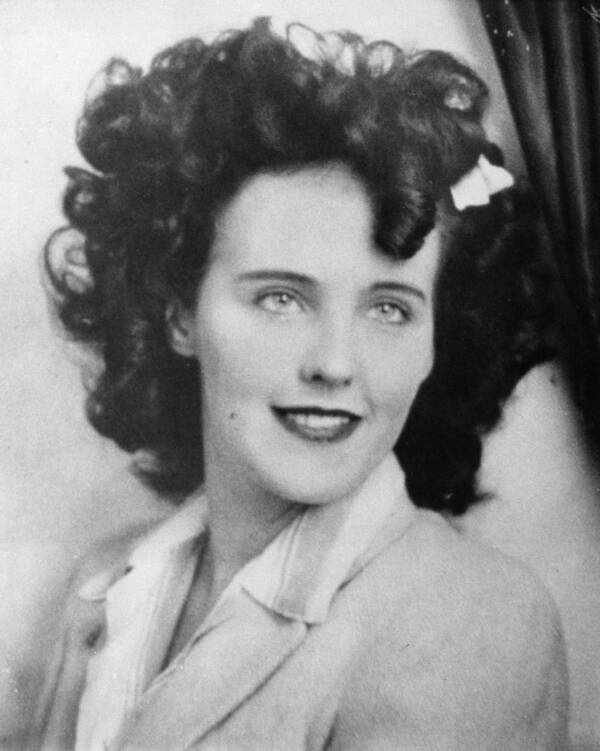Have you ever heard of the chilling story behind the Glasgow Smile and its connection to Elizabeth Short? If not, buckle up because this is one dark tale that will leave you questioning the depths of human cruelty. Elizabeth Short, famously known as the Black Dahlia, became an infamous figure in crime history, partly due to the brutal nature of her murder. The Glasgow Smile, a grotesque method of mutilation, played a central role in her tragic story. Today, we're diving deep into this disturbing case and uncovering the truth behind the headlines.
This isn't just another true crime story; it's a glimpse into the darkness that lurks in the shadows of human nature. Elizabeth Short's case remains one of the most infamous unsolved murders in American history, and the Glasgow Smile became a symbol of the brutality she endured. It's a story that continues to haunt investigators, historians, and true crime enthusiasts alike. So, why does this case still matter so much today?
Well, the Glasgow Smile Elizabeth Short connection isn't just about the horror of the crime itself. It's also about the unanswered questions, the media circus that surrounded the case, and the enduring mystery of who could have committed such a heinous act. In this article, we'll explore everything you need to know about Elizabeth Short, the Glasgow Smile, and why this case continues to fascinate and terrify people around the world.
Table of Contents
- Biography of Elizabeth Short
- What is the Glasgow Smile?
- The Connection Between Elizabeth Short and the Glasgow Smile
- The Investigation and Unsolved Mystery
- The Role of the Media
- The Impact on True Crime Culture
- Forensic Advances and the Case
- Modern-Day Speculations
- Psychology Behind the Glasgow Smile
- Conclusion: Why This Case Still Matters
Biography of Elizabeth Short
Early Life and Background
Elizabeth Short was born on July 29, 1924, in Boston, Massachusetts. Her life, however, was far from ordinary. Known for her beauty and charm, Elizabeth dreamed of becoming a Hollywood star. But her journey to fame was cut tragically short. Before moving to California, Elizabeth lived a relatively normal life, working various jobs and occasionally modeling.
Her family life was complicated, to say the least. Her father, Albert Short, abandoned the family when Elizabeth was a child, only to reappear years later. This instability left a lasting impact on her life and possibly influenced her decisions later on.
Let's take a quick look at her personal details:
| Name | Elizabeth Short |
|---|---|
| Birthdate | July 29, 1924 |
| Place of Birth | Boston, Massachusetts |
| Nickname | Black Dahlia |
| Occupation | Aspiring actress |
What is the Glasgow Smile?
The Glasgow Smile is a chilling term used to describe a specific type of facial mutilation where the corners of the victim's mouth are cut, stretching the smile unnaturally. This barbaric act has been used in various contexts throughout history, often as a form of psychological torture or a signature left by a sadistic killer.
But why is it called the Glasgow Smile? Well, it's believed to have originated in Glasgow, Scotland, where it was reportedly used by gangsters as a warning or punishment. The term gained notoriety in popular culture through its association with the Black Dahlia case, making it one of the most infamous symbols of violent crime.
Origins and Historical Context
While the exact origins of the Glasgow Smile are debated, it's clear that it has been used in various parts of the world as a tool of intimidation. In the case of Elizabeth Short, the Glasgow Smile was not just a random act of violence; it was a deliberate choice by the killer, possibly meant to send a message or to taunt investigators.
The Connection Between Elizabeth Short and the Glasgow Smile
When Elizabeth Short's body was discovered on January 15, 1947, in a vacant lot in Leimert Park, Los Angeles, the world was shocked by the brutality of the crime. Her body was found divided in half at the waist, with her face bearing the infamous Glasgow Smile. This mutilation became a defining feature of the case and a symbol of the extreme violence inflicted upon her.
But why did the killer choose this particular method? Was it personal, or was it simply a way to create a spectacle? The Glasgow Smile Elizabeth Short connection continues to baffle investigators and true crime enthusiasts alike.
Why the Glasgow Smile?
Some theories suggest that the Glasgow Smile was used to dehumanize Elizabeth, turning her into an object rather than a person. Others believe it was a signature left by the killer, a way to mark their work and taunt the authorities. Whatever the reason, it's clear that the Glasgow Smile played a significant role in the Black Dahlia case.
The Investigation and Unsolved Mystery
The investigation into Elizabeth Short's murder was extensive, involving hundreds of detectives and generating thousands of leads. Despite this, the case remains unsolved to this day. The Glasgow Smile became a focal point of the investigation, with experts trying to determine its significance and possible connection to other crimes.
Over the years, numerous suspects have been named, but none have been conclusively linked to the crime. The lack of physical evidence and the passage of time have made it increasingly difficult to solve the case. Still, the Glasgow Smile Elizabeth Short connection continues to intrigue and frustrate investigators.
Challenges in the Investigation
One of the biggest challenges in the investigation was the overwhelming amount of misinformation and false leads. The media circus surrounding the case made it difficult for investigators to separate fact from fiction. Additionally, the lack of modern forensic techniques at the time hindered their ability to gather conclusive evidence.
The Role of the Media
The media played a significant role in shaping the public's perception of the Black Dahlia case. Sensational headlines and graphic images helped fuel the public's fascination with the case, turning Elizabeth Short into a tragic icon. The Glasgow Smile became a defining feature of her story, symbolizing the brutality and mystery surrounding her death.
But the media's involvement wasn't all negative. It also helped bring attention to the case and keep it in the public consciousness, ensuring that it wasn't forgotten over time.
Impact on Public Opinion
The media's portrayal of Elizabeth Short and the Glasgow Smile had a lasting impact on public opinion. It turned her into a symbol of the dangers faced by women in society and highlighted the need for better protection and justice for victims of violent crime.
The Impact on True Crime Culture
The Black Dahlia case, with its focus on the Glasgow Smile, has had a profound impact on true crime culture. It has inspired countless books, movies, and documentaries, each offering its own interpretation of the events. The Glasgow Smile Elizabeth Short connection continues to captivate audiences, ensuring that her story remains relevant in today's world.
But why does this case still resonate so strongly with people? Is it the mystery, the brutality, or something else entirely? Whatever the reason, the Black Dahlia case remains one of the most fascinating and tragic stories in true crime history.
Modern-Day Fascination
Today, the Glasgow Smile Elizabeth Short connection continues to inspire new generations of true crime enthusiasts. With the rise of podcasts and streaming services, the case has found new life, reaching audiences around the world. This renewed interest has helped keep Elizabeth's memory alive and her story relevant.
Forensic Advances and the Case
Advances in forensic science have provided new insights into the Black Dahlia case, offering possible explanations for the Glasgow Smile and other aspects of the crime. DNA analysis, facial reconstruction, and other techniques have helped investigators piece together the events surrounding Elizabeth's death.
However, despite these advances, the case remains unsolved. The Glasgow Smile continues to be a central focus of the investigation, with experts trying to determine its significance and possible connection to other crimes.
What Forensics Can Tell Us
Forensic analysis has revealed important details about the Glasgow Smile, including the type of weapon used and the skill level required to perform such a precise mutilation. This information has helped investigators narrow down potential suspects and theories, although it hasn't led to a definitive conclusion.
Modern-Day Speculations
Even today, new theories and speculations about the Black Dahlia case continue to emerge. Some suggest that the Glasgow Smile was the work of a serial killer, while others believe it was a random act of violence. Whatever the truth may be, the Glasgow Smile Elizabeth Short connection remains one of the most intriguing mysteries in true crime history.
With advancements in technology and new evidence coming to light, there's always hope that the case may one day be solved. Until then, the Glasgow Smile will continue to haunt the memories of those who seek answers.
Unanswered Questions
Despite decades of investigation, many questions about the Glasgow Smile and Elizabeth Short's murder remain unanswered. Who was the killer? Why did they choose this particular method of mutilation? And will we ever know the truth? These questions continue to drive the search for answers and keep the case alive in the public consciousness.
Psychology Behind the Glasgow Smile
Understanding the psychology behind the Glasgow Smile can provide valuable insights into the mind of the killer. Experts believe that the act of mutilation may have been a way for the killer to exert control over their victim, turning them into an object rather than a person. This dehumanization is a common theme in violent crimes and can help explain the brutality of the Glasgow Smile.
But what drives someone to commit such a heinous act? Is it a desire for power, a need for control, or something else entirely? These questions continue to puzzle psychologists and criminologists alike.
Inside the Mind of a Killer
Studying the psychology of the Glasgow Smile can help us better understand the motivations behind such violent acts. By examining the behavior and actions of the killer, we can gain insights into the darker aspects of human nature and the reasons behind such extreme acts of violence.
Conclusion: Why This Case Still Matters
The Glasgow Smile Elizabeth Short connection remains one of the most fascinating and tragic stories in true crime history. From its origins in Glasgow, Scotland, to its association with one of America's most infamous unsolved murders, the Glasgow Smile has become a symbol of the brutality and mystery surrounding Elizabeth's death.
While the case may never be solved, the Glasgow Smile continues to captivate and terrify people around the world. It serves as a reminder of the darkness that can exist in human nature and the enduring mystery of unsolved crimes.
So, what do you think? Do you believe the Glasgow Smile holds the key to solving the Black Dahlia case? Or is it simply a chilling reminder of the brutality of human nature? Share your thoughts in the comments below and let's keep the conversation going.
.jpg/800px-Tommy_Flanagan_March_2012_(cropped).jpg)

